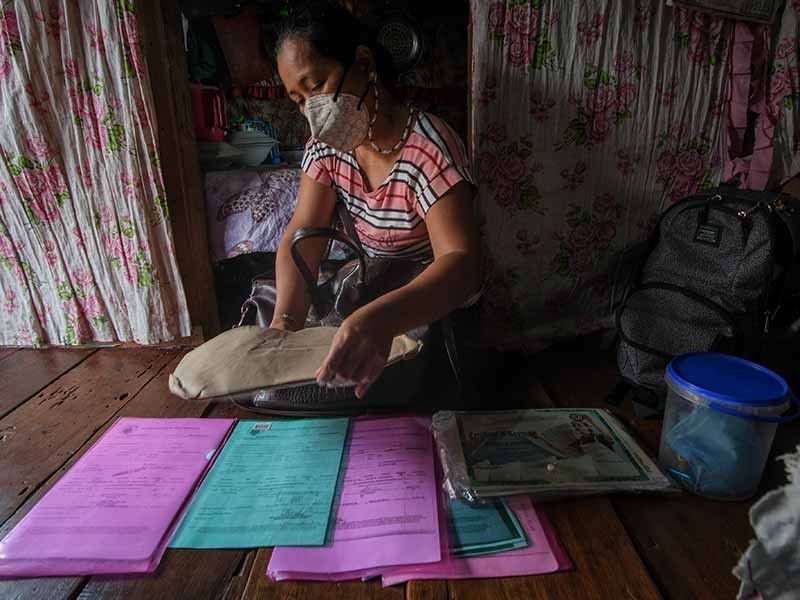'Yolanda' survivors juggle safety and need for livelihood, services

Part 1 of a two-part feature.
Part 2: Powering Tacloban's poor: Making renewable energy relatable and within reach
TACLOBAN CITY, Philippines — Inside a house originally built for pigs and chickens, Lerma Maceda grabs three bags.
The first is packed with a set of neatly-rolled emergency clothes, the second has important documents and papers for work, and the third has blister packs of medicine for first aid.
For her family, this is the best disaster preparation they can practice for typhoons.
Maceda is one of the over 4 million people displaced by Supertyphoon Yolanda in 2013. While thousands have already been given relocation sites, she is one of the less fortunate residents still waiting for a new home.
Originally a resident of the Downtown area, one of the busiest centers in Tacloban, Maceda moved to a house in the Anibong district closer to the sea.
Stilts keep the floor of her house above the water. "I don't sleep at night when there are typhoons or during high tide. I have to watch if the water will reach our floor," she said.
Eight years after 'Yolanda', one of the strongest cyclones recorded in history, survivors still face issues on resettlement as well as lack of livelihood and access to basic social services such as running water and electricity.
Residents began to transfer to housing sites in 2016. Despite having shelter inside cemented walls, they still experience a different face of displacement.
According to Tedence Jopson, the officer-in-charge of the City Housing and Community Development in Tacloban, about 14,000 families have already settled in 23 relocation sites put up by the government or by non-governmental organizations.
"Sad to say, government houses only have 64.02% [occupancy], while housing from NGOs have 87.84%," Jopson stated.
According to data from the LGU, housing units have been raffled off to 15,209 beneficiaries.
While Maceda is still waiting for an opportunity to relocate, she also thinks that staying a nine-peso jeepney ride away from Downtown— where she works as an insurance agent, is better than paying P25-30 for a half an hour commute if she moves to the relocation sites around Northern Tacloban.
From her home, Maceda points to the road going to Downtown.
"How much would that cost if all of us in our family have to go there?" she said, computing the fare for a family of six.
"I might as well endure staying here while there's no housing for us," she added.
Relocatees need more than houses
One of the housing units in Tacloban. This one was put up by a non-governmental organization.
Daily, Christine Badanoy, one of the housing beneficiaries, is reminded of the tragedy of Yolanda.
Her 6-year-old son drowned after being carried away by the storm surge that hit the city. Then pregnant, she gave birth due to the stress induced by the calamity.
Badanoy, with the son born in the aftermath of the typhoon, shows a photo of the son she lost.
"I lost one child that day, but another came to take his place," she recounted.
"We like it here, it’s quiet, and since it’s made of cement, it’s stronger against typhoons. But our main problem is the lack of livelihood," she said.
Five years have passed since Badanoy’s family relocated, but there is still no running water at home.
The 45-year-old mother of seven is unemployed and budgets the P295 her husband earns daily as a utility man in the Downtown district. He earns P50 above the regional minimum wage of P325, but the commute already accounts for a third of what he makes.
Josephine Crisostomo in her sari-sari store.
Badanoy's neighbor, Josephine Crisostomo, has a small sari-sari store in their community. Only members of a local cooperative are allowed to put up stores at the relocation sites. Out of desperation, she disobeyed the rule and opened one despite not being a member.
"You need to pay a high annual fee to the cooperative to own a sari-sari store. We can't afford that," Crisostomo said. "They told me to close this down, or else my son’s scholarship would be affected."
A fisherman from Anibong shows his catch.
For Marilyn Delingon, whose husband is a fisherman, the solution is to stay in Anibong on weekdays and visit their home at the relocation site on weekends.
Delingon was born and raised in the coastal area. She studied at the elementary school a few steps away from their house, which has since been washed out because of Yolanda.
Now her family of 11 lives in their cousin's house near the sea, where they can easily keep an eye on their boat.
She earns roughly P1,200 a month juggling multiple part-time jobs. Her husband also finds it difficult to earn from fishing when the rising prices of diesel quickly consume their very small capital.
"We go to our relocated homes during the weekend, because it’s expensive to go back and forth daily. When there are typhoons, we evacuate and go up to the North," Marilyn explained.
Lack of livelihood, services felt more sharply
Delingon and her family stay in Anibong on weekdays.
Ronan Napoto, co-founder of Balud, a youth-led movement that promotes ecological consciousness in Eastern Visayas recalled hearing a powerful statement from a fisherman defending their homes years ago.
"If the mayor wants us to relocate, then he should teach us how to grow seashells inside a dipper," Napoto quoted the fisherman as saying.
Napoto said it appealed to him, because while the most of the marginalized recognize the importance of safer homes, the need to make sure they have sources of income to fill their stomachs weights heaviest on their minds.
He said that the relocation plan should have been planned better from the start as the transportation to and from northern barangays had always been a challenge. He added that access to water had been a problem in areas north of the city even before Yolanda.
For the youth advocate, these problems got worse because issues on livelihood and access to basic social services were not addressed first.
"I can’t really blame the people for not wanting to relocate fully, I know a lot of families who still have homes in the city because that’s really where they are based," he said.
He said that while there have been efforts to give the residents of relocation sites alternative sources of income, "in one block, everyone was taught how to manicure and pedicure and were encouraged to open sari-sari stores, so residents asked who their customers would be if everyone can do it themselves."
'Just relocation' needed
Xian Guevarra, national coordinator of Youth Advocates for Climate Action Philippines (YACAP), said that relocation is necessary for climate adaptation in the country.
"We really have areas that will be permanently flooded, and areas that geographically weren’t meant to be residential, and sadly current technology and science has not come up with a solution other than relocation," said Guevarra.
"And since relocation is certainly part of addressing disaster risks, what governments should be pushing is 'just relocation'," he added.
Guevarra said the Philippines can pick up lessons from how relocation was done in Cuba.
"They started by providing an intensive educational campaign about the benefits of relocating so residents would understand its gravity, coupled with ensuring that the people would have alternative livelihoods based on the skillset the relocatees already have," explained Guevarra.
The experiences of the women survivors of Yolanda from eight years ago shaped the way they approach typhoons and disasters at the present.
And while each employs their own disaster preparedness measures and is aware of their evacuation plans, what these mothers hold most important is how they will feed their families on a daily basis.
Geela Garcia is a freelance multimedia journalist and peasant advocate based in Manila.
- Latest






























